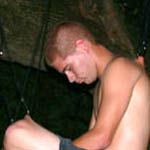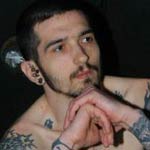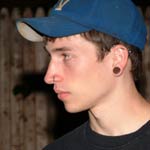
BME: |
What was your experience in the body modification community before getting involved with Rites of Passage?
|

BRIAN: |
Before I began working with suspensions with ROP I was heavily involved with practicing modification work in Connecticut. I worked with piercing, implants, scarification, and many other more “pseudo-surgical” aesthetic modifications at the time.
|

CERE: |
I was a body piercer of about five or six years and then I left piercing due to the fact that in New York even the best piercers can’t maintain a high enough standard of living (for me). Afterwards though, I remained “in the scene” by working on friends only, and going to conventions, clubs, and so on.
|

EMRYS: |
I’d been a body piercer for about two years at a local studio in my home town and served an apprenticeship under a traditional Fakir-trained piercer. I’d experimented when I was younger (nine-ish) with branding myself, cutting myself, and carving words in my skin as a relief of tension. I started stretching my lobes at around thirteen as a result of meeting a Kenyan tribesman that came to my school to give a speech on his culture. I also had a decent amount of tattoo work for someone under the age of eighteen, including a memorial tattoo crowning my head in dedication to my mother.
|
| |
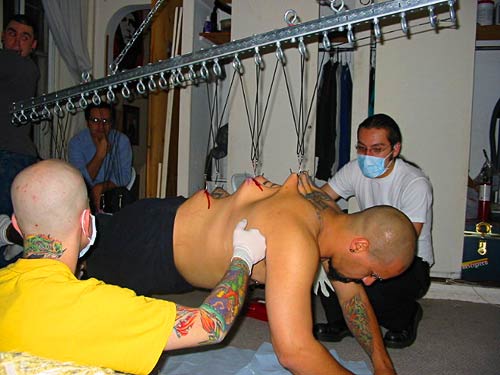
Cere's first suspension being watched over by Brian (front)
and George (back), with Emrys working in the background.
|

BME: |
How did you three meet each other and the rest of ROP?
|

BRIAN: |
I actually learned the most about suspension from Emrys as a trade for modification work. Implants for a first suspension! Even trade. From then on I was really interested in learning the techniques and arts involved with performing suspension and helped out whenever I could.
Rites of Passage was in its beginning stage at the time. Em was living in Pittsfield (Massachusets) then, and most of my trips up there to visit involved suspension at some level — I learned more about knotting and rigging every time. It wasn’t really until Em moved to NYC with me that I began to become as knowledgeable as I am now, though. That’s when ROP-NYC started to grow.
|

CERE: |
I know this is going to sound clichéd, but I’d always wanted my tongue split. Well, not always, but ever since I’d seen one in person, I wanted one. The first time I ever saw it was on a cute chick in St. Marks Place (a strip filled with modders in New York City). Unfortunately everyone that I knew who performed the procedure wasn’t producing results I was happy with, so I turned my search online and came across BME. I ended up meeting up with Brian, and we hit it off and became friends. At the time him and Emrys were roommates in NY, and we all just kind of hit it off.
|

EMRYS: |
Besides the few members that were there when it was just an idea, most of the members are people that I’d suspended with ROP or other groups I’ve worked with that then became interested in helping others experience what they had. The “original members” — let’s say first year — were people that were into piercing and tattooing and so on that I knew from my hometown area and had become friends with due to our similar interests.
|

BME: |
Did you seek out training in ritual rites or did it simply present itself?
|

BRIAN: |
I guess, perhaps, I subconsciously sought out the teaching, as I was definitely interested in learning, but it wasn’t until Emrys actually presented me with the opportunity that I really knew it was something possible to pursue.
|

CERE: |
Although I was always interested in suspension and played with the idea of it, I never thought the opportunity to hang, let alone be part of this, would ever come. It’s not something I sought out — actually it was something I thought I’d never come across! I was just at the right place at the right time with the right friends.

Cere and Ellie doing a night pull on the beach
|

EMRYS: |
The answer depends on what you narrow down as “ritual”. In my opinion any form of modification to the body holds some form of ritualistic intensity. I’m sure you’re meaning suspension and so on, and I had to seek out information and guidance in that area.
Being nowhere near as popular then as it is now there were very few individuals with actual experience with it. Through BME and suspension.org I came in contact with people like Allen Falkner and Steve Joyner who offered me guidance and answers — though I’d have to say 75% of what I know came from trial and error, along with first hand accounts. At first the group was closed to anyone besides ourselves in order to become more experienced so that we could safely share suspension with other people.
|

BME: |
What did your training actually consist of?
|

BRIAN: |
Being an established modification practitioner I was well versed with the concepts of avoiding cross contamination, having proper bedside manner, and aseptic technique, so the first thing I needed to “learn” was the art of hook throwing. I learned a few different styles of piercing, which I caught onto very quickly. “Training” really consisted mostly of hands-on experience working next to Em, as he explained what he was doing — and why — throughout each suspension.
Learning how to tie different knots was mostly just a memorization skill, but where to put the hooks and tie the knots and why, and when a person needed to come down, was the part of suspension that needed to be learned through experience and practice.

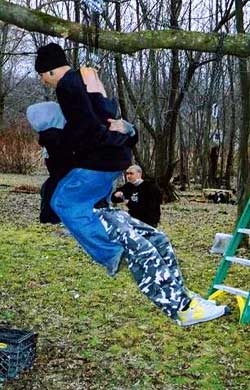
Brian suspending; one hook chest and multi-point suicide
|

CERE: |
I’m not going to go in depth here, giving a play by play, but it started slowly learning one aspect at a time and not moving on to new things until I was comfortable that I could do it.
|

EMRYS: |
Training is a lot to cover in one question and could be broken down into a rather large number of categories. As Brian said, a lot of the piercing of the hooks and bloodborne pathogens and other technical aspects came from being a body piercer — the rest was learning knots, talking to those that had paved the way, learning ways to calm people as they go from beginning to end, learning better ways to rig this, faster knots for that, and so on. Almost all of it was learned hands-on — it’s not something that can be read and learned. It’s all about being walked through it, and when you have no one, you walk yourself through it. I’m not sure if that answered your question but it’s rather hard to answer that without writing a book!
|

BME: |
How did ROP manage to establish itself so well? It’s a very respected group.
|

BRIAN: |
I believe ROP is so well respected because of the dedication we all have to making each suspension meaningful for each and every person on both personal and professional levels. We all breathe suspension all the time, and take as much concern with learning as anything we’d like to be the best at. We’re all really easy to talk to and all generally care about your experience being the best it can possibly be, which is what makes ROP what it is.
|

CERE: |
God, this is going sound so high and mighty but I think what makes ROP so unique is a couple things. First off, we are clean. We will not cut corners under any circumstances, and we will never jeopardize a suspendee. I’d have no problem throwing away a 100' spool of rope if it was contaminated. Also we are people. We don’t have an attitude or rockstar mentality. We’re here to help people, not to be “cool.”
|

EMRYS: |
We just did what we do, nothing more, nothing less. ROP is something that comes from my heart and the hearts of all its members. We all do it for the one reason and one reason only: the love of the art of suspension. Each and every member was once a first time suspendee who was nervous and scared, who we walked through each step to help their experience be the most positive and safe it could possibly be. And I think that’s how we managed to establish ourselves. By always being open and patient with people who come to us and the level of professionalism we have to offer for something that can’t help but be personal. We’re dedicated to what we do as more of a lifestyle than a hobby — it’s not making scrapbooks — it’s a life changing experience for that person so we make sure it’s for the better.

Emrys and Brian working together
|

BME: |
Emrys, I’ve been told that you are the main reason that ROP has branched out so much. How have you been able to set up so many different chapters? It seems as if you’re the Tyler Durden of suspension!
|

EMRYS: |
Besides being the person that started the group, I was always willing to share the knowledge I had learned with others. If someone came to me or another member of the group and showed true interest in learning to help other people experience suspension, they deserved to be taught. Also, a large part of it has to do with the amount I try and travel. In addition, the few times I’ve moved around, I've tried to develop a suspension group wherever I went.
I mean, once you suspend someone, you change their life. A lot of the time you develop a bond with that person they are forever thankful for, and every now and then they want to be able to pass that feeling on. I’ve been rather fortunate as well to have so many genuine people come to me and want to learn, and become part of the group. We prefer to refer to ourselves as a family, and I look at each chapter as a household — some bigger, some smaller, but all just as important as the other.
|

BME: |
What do you want the future to hold for ROP?
|

BRIAN: |
There really isn’t much more I can hope for ROP to accomplish as a group, except to keep the same practicing techniques and love for the art as we all have now for any new members we work with. All of us involved with ROP definitely have a strong heart for suspension. Shock value is not important.
|

CERE: |
Honestly? I’d like to build a center devoted to suspension. I plan to do it within the next two years so we could have a permanent open space for us to use.
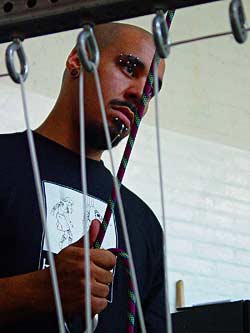

Cere and his ROP cutting, done by Brian
|

EMRYS: |
We can only prosper. I feel I couldn’t ask for a better crew of individuals scattered through this country. We’ll continue to focus on personal suspension for first timers and private ritual suspensions, though we’ll continue to hold Suscon events, BBQ events, along with performances and more interesting rigging styles and developments to help push the ever growing community that is suspension.
|

BME: |
Is there anything else you would like to add?
|

BRIAN: |
If you would like to suspend with ROP or learn more about the group, you can visit us on the web at ariteofpassage.org. Contact info is available there to set up scheduling for a personal suspension as well.
|

EMRYS: |
Over the past years I’ve been doing this it's consumed my life. I’ve helped change the lives of thousands of people throughout the world. It was originally for me, to fill a personal void in my heart, but has become a selfless act I now perform to help others in hopes it can reach them on any level close to how it’s reached me.
I’d also like to thank Allen Falkner for all his patience and sharing his knowledge, and also taking the place of a father figure I never had. Too little people appreciate and acknowledge the amount he’s given to the modern suspension community.

|

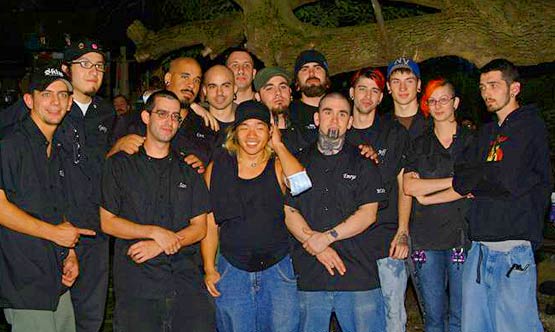









 Current ROP (January 2005)
Current ROP (January 2005)


